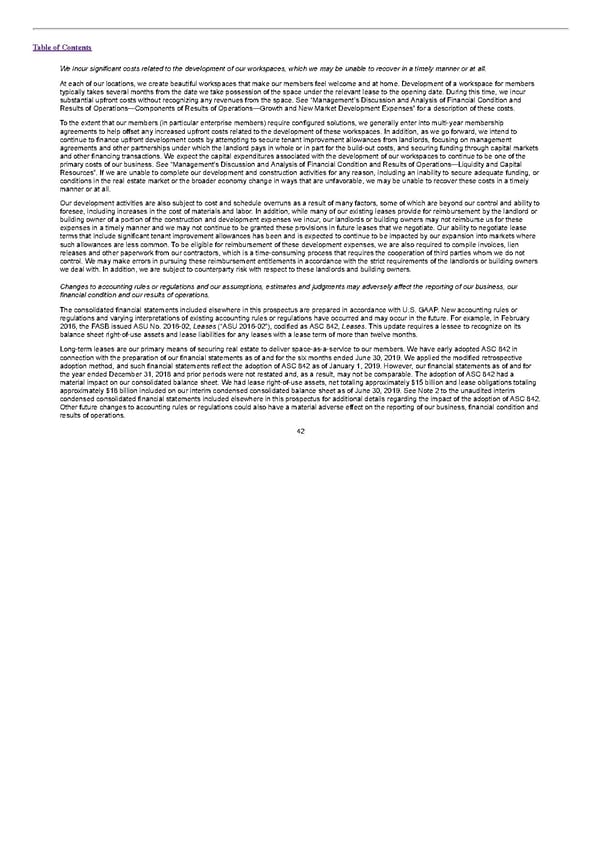Table of Contents We incur significant costs related to the development of our workspaces, which we may be unable to recover in a timely manner or at all. At each of our locations, we create beautiful workspaces that make our members feel welcome and at home. Development of a workspace for members typically takes several months from the date we take possession of the space under the relevant lease to the opening date. During this time, we incur substantial upfront costs without recognizing any revenues from the space. See “Management’s Discussion and Analysis of Financial Condition and Results of Operations—Components of Results of Operations—Growth and New Market Development Expenses” for a description of these costs. To the extent that our members (in particular enterprise members) require configured solutions, we generally enter into multi-year membership agreements to help offset any increased upfront costs related to the development of these workspaces. In addition, as we go forward, we intend to continue to finance upfront development costs by attempting to secure tenant improvement allowances from landlords, focusing on management agreements and other partnerships under which the landlord pays in whole or in part for the build-out costs, and securing funding through capital markets and other financing transactions. We expect the capital expenditures associated with the development of our workspaces to continue to be one of the primary costs of our business. See “Management’s Discussion and Analysis of Financial Condition and Results of Operations—Liquidity and Capital Resources”. If we are unable to complete our development and construction activities for any reason, including an inability to secure adequate funding, or conditions in the real estate market or the broader economy change in ways that are unfavorable, we may be unable to recover these costs in a timely manner or at all. Our development activities are also subject to cost and schedule overruns as a result of many factors, some of which are beyond our control and ability to foresee, including increases in the cost of materials and labor. In addition, while many of our existing leases provide for reimbursement by the landlord or building owner of a portion of the construction and development expenses we incur, our landlords or building owners may not reimburse us for these expenses in a timely manner and we may not continue to be granted these provisions in future leases that we negotiate. Our ability to negotiate lease terms that include significant tenant improvement allowances has been and is expected to continue to be impacted by our expansion into markets where such allowances are less common. To be eligible for reimbursement of these development expenses, we are also required to compile invoices, lien releases and other paperwork from our contractors, which is a time-consuming process that requires the cooperation of third parties whom we do not control. We may make errors in pursuing these reimbursement entitlements in accordance with the strict requirements of the landlords or building owners we deal with. In addition, we are subject to counterparty risk with respect to these landlords and building owners. Changes to accounting rules or regulations and our assumptions, estimates and judgments may adversely affect the reporting of our business, our financial condition and our results of operations. The consolidated financial statements included elsewhere in this prospectus are prepared in accordance with U.S. GAAP. New accounting rules or regulations and varying interpretations of existing accounting rules or regulations have occurred and may occur in the future. For example, in February 2016, the FASB issued ASU No. 2016-02, Leases (“ASU 2016-02”), codified as ASC 842, Leases. This update requires a lessee to recognize on its balance sheet right-of-use assets and lease liabilities for any leases with a lease term of more than twelve months. Long-term leases are our primary means of securing real estate to deliver space-as-a-service to our members. We have early adopted ASC 842 in connection with the preparation of our financial statements as of and for the six months ended June 30, 2019. We applied the modified retrospective adoption method, and such financial statements reflect the adoption of ASC 842 as of January 1, 2019. However, our financial statements as of and for the year ended December 31, 2018 and prior periods were not restated and, as a result, may not be comparable. The adoption of ASC 842 had a material impact on our consolidated balance sheet. We had lease right-of-use assets, net totaling approximately $15 billion and lease obligations totaling approximately $18 billion included on our interim condensed consolidated balance sheet as of June 30, 2019. See Note 2 to the unaudited interim condensed consolidated financial statements included elsewhere in this prospectus for additional details regarding the impact of the adoption of ASC 842. Other future changes to accounting rules or regulations could also have a material adverse effect on the reporting of our business, financial condition and results of operations. 42
 S1 - WeWork Prospectus Page 46 Page 48
S1 - WeWork Prospectus Page 46 Page 48